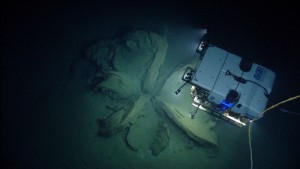
At a depth of nearly four miles, with four tons of crushing pressure on every square inch, in the pitch black of the deep ocean, the Remotely Operating Vehicle (ROV) Deep Discoverer lurks. Known as D2, the robot is operated by a team on the NOAA mother ship Okeanos, and via miles of cable sends back exquisite high-definition imagery from the unexplored seafloor. D2 is tethered to its sister vehicle, Seirios, which lights D2 from above and with its own cameras allows operators an expanded view of the ROV and its surroundings. Seirios in turn is dangled from Okeanos at the end of miles of steel-armored cable with a fiber-optic core. The cable provides power to the duo and is a conduit for communications and telemetry.
D2 illuminates its surroundings with brilliant LED lights, allowing its nine video cameras to capture an unparalleled view of the seafloor and close-up glimpses of the remarkable creatures that lurk there. And via telepresence, anyone, anywhere with an Internet connection can follow the excitement of discovery with scientists, watching it unfold as it happens. D2 can also grab samples of marine life and geology for further study topside.
The Nauticos-SeaWord team will be looking with great anticipation to seeing what D2 reveals when it dives on the Battle of Midway site near the end of its current mission to explore the Northwest Hawaiian Islands Marine National Monument in early March.

